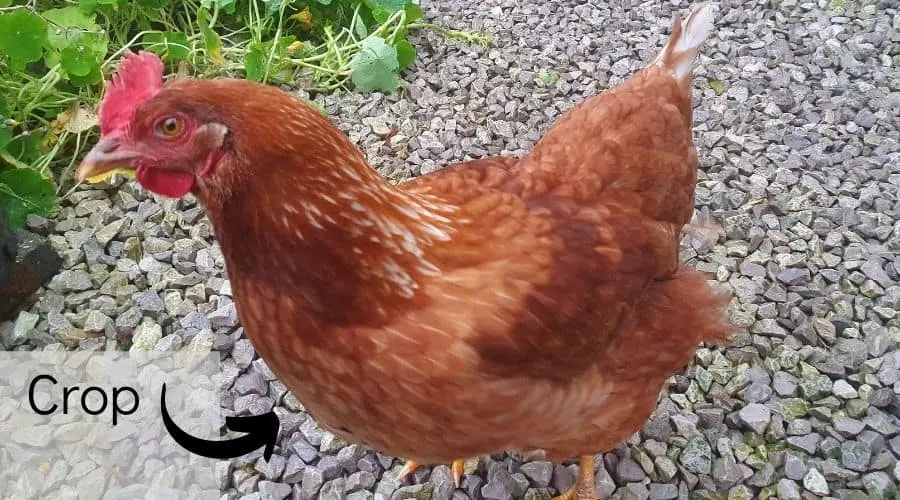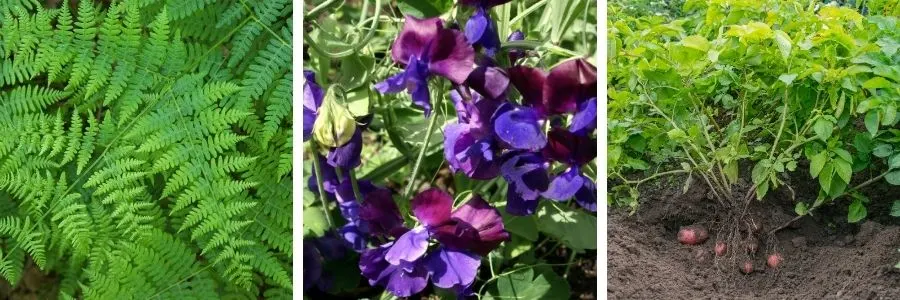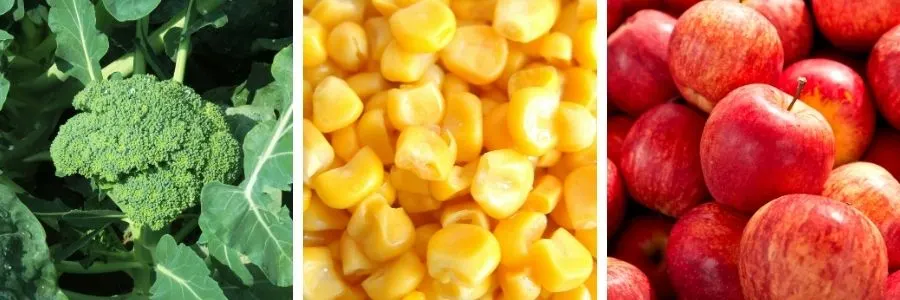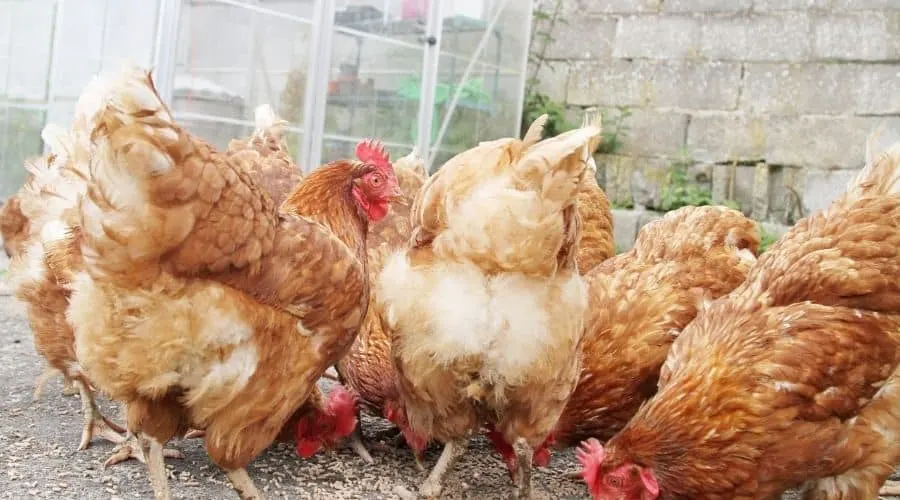In this complete guide, I’ll show you everything you need to know about feeding chickens including, chicken feeds, treats and natural foods which they can forage for as they graze.
What you feed chickens depends on their age and how much time they spend going ‘free-range’.
Most good quality chicken feeds contain everything they need, but it’s important to know when and how this food should be given to keep chickens healthy and happy. So, what should chickens eat:
Chickens should eat a diet primarily of commercial poultry feed, supplemented with grains, vegetables, and occasional protein sources like worms or leftovers. Avoid toxic foods like chocolate, avocado, and raw beans.
The cornerstone of a chicken’s diet is commercial poultry feed, which is formulated to provide all the essential nutrients they need. Layer feed is ideal for egg-laying hens, while starter and grower feeds are designed for chicks and young chickens. Supplementing this with grains such as corn or wheat can provide additional energy, especially in colder months. Vegetables and fruits are excellent for variety and additional vitamins, but should only be given in moderation. Occasional treats like mealworms or small amounts of cooked meat can offer extra protein, beneficial during molting or when hens are laying eggs.
However, it’s crucial to avoid certain foods that are harmful to chickens. These include chocolate, avocado, raw beans, and anything moldy or spoiled. Foods high in salt and fat should also be limited, as they can lead to health issues. Always ensure that treats and supplements do not make up more than 10% of their diet to maintain nutritional balance. Clean, fresh water should be available at all times, as hydration is as important as nutrition for chickens. Regularly cleaning feeders and waterers to prevent contamination is also essential for their health.
Read on through my complete guide to find out much more about the best way to feed chickens, along with feeding by age, feeding chickens do’s and don’ts, natural foods, treats, how much you should feed and when.
Feeding chickens by age
Knowing what to feed chickens by age, especially in the first 18 weeks is important because the wrong food, while they’re developing, can cause long-term damage to the chicken.
It’s really the same principle of feeding a baby, but the transition process is much quicker. They start with baby food, then move onto food which is more filling but full of nutrients and then when they become layers they need food designed to support egg production.
The important part is, that chickens aren’t given food designed for layers while they’re still in the growing phase as this can lead to long term kidney damage.
Chicken feed can be bought in various forms, including crumb, mash, pellets and mixed seeds and grains.
The table below shows as a guide what to feed chickens at each stage of their life, along foods which they can eat alongside their main feed:
| Chicken age | Feed type | Feed forms available | Supplements |
| 7 weeks or less | Chick crumb | Small crumb which is easy for chicks to eat | Natural foraged foods, boiled egg |
| 8 to 20 weeks | Growers feed | Seeds & grains, pellets and mash | Corn mixes, natural foraged foods, fruit & veg, specialist food supplements |
| 18-20 weeks onwards | Layers feed | Pellets and mash | Corn mixes, natural foraged foods, fruit & veg, specialist food supplements |
| Specialist breeds & show birds | Same as other chickens at each age stage | Seeds & grains, pellets and mash | Specialist breed foods and supplements designed for a specific breed |

To find out more about what to feed your chickens by age, click on the link below to see the full post:
What should chickens eat by age
Changing chicken feed from growers to layers
Hens move onto layers pellets when they become egg layers because the feed contains more calcium which helps to create a strong eggshell along with added nutrients which laying birds need.
There’s varying advice out there as to when you should move from growers to layers feed, along with what age chickens start to lay eggs.
In my experience of keeping chickens most will start to lay at around 18-20 weeks, although this will vary from hen to hen.
Chickens can also become a little bored with their growers feed and when you present them with layers mash or pellets for the first time you’ll probably find that they can’t get enough.
If you’re looking to transition your chickens onto layers feed and you still have growers feed to use up, it’s a good idea to make a mix as they get used to their new food.
If your chickens haven’t had food in pellet form before they shouldn’t have a problem switching over, but you can use mash or soak pellets in some water to make it easier to eat when they’re young.
Feeding chickens grit for digestion
When chickens eat food it’s initially stored in the crop which is located at the front of the bird’s chest (see image below).
Chickens don’t have teeth so the food is stored in the crop where it will begin to soften in preparation for digestion. The crop will usually empty overnight into and organ, where the food is ground up, called the gizzard.
To aid this grinding process the chickens swallow small pieces of grit which help to grind up the food.
The best grit for this job is flint which is available in different grades depending on the age of the chicken.
Grit is particularly important for young chicks of around 6 weeks old who are about to move onto food containing seeds and grains and for birds of any age that don’t go free-range.
Adult birds who go free-range will pick up grit as they graze so it’s not essential to provide them with grit although it doesn’t harm to offer some grit in a feeder if your chickens only free-range for a short period of time.

You can find out more about grit for chickens in my post via the link below:
Do chickens need grit and oyster shells and what’s the difference?
What do roosters eat?
When you read advice on what to feed chickens it’s mainly geared around laying hens, but what food do you give to roosters?
Rooster chicks and growers will eat the same as a female hen (see the table above) if you keep hens who are eating layers pellets they will also eat these too. Layers pellets contain a higher amount of calcium which will not do the rooster any harm.
It is also difficult to keep a rooster away from the hens’ food unless they are kept in separate areas.
One alternative is to feed the whole flock with growers feed and provide oyster shell separately which acts as a calcium supplement for laying birds.
You can buy added supplements for roosters and it’s also a good idea to supplement the pellets with other foods such as corn mixes too.
Feeding ex-battery and rescue chickens
When hens are kept in a commercial situation they are generally fed with layers mash which is much quicker to eat meaning they can spend more time concentrating on laying.
This means that when you take in an ex-battery hen they will probably have been fed on mash throughout their lives and will not be used to pellets as food.
Although in most cases rescue hens will happily eat pellet food, it’s good to offer them mash when they first come to you while they get used to their new home.
If you only have pellets you can simply pour some water over them to create a mash type texture which they can easily eat.
In some cases, chickens may have had their beaks clipped to stop them from pecking and mash might be much easier for them to eat on a long-term basis.
What do chickens eat naturally ?
Chickens love to forage for natural food from a very early age, in fact, very young chicks instinctively know how to scratch with their feet to unearth tasty treats.
When a chicken is scratching and grazing for food they will be foraging for the following natural foods:
Natural food sources are packed full of nutrients which help the chickens to stay healthy and best of all its free food!
There are some plants and mushrooms which can be poisonous to chickens but don’t worry too much about every single plant which is growing in your garden because they will instinctively know what is not good.
You can find out more about natural eating for chickens in my full post via the link below:
What do chickens eat naturally when they graze?
What plants are poisonous to chickens?
Although there are many plants which are poisonous to chickens, this doesn’t mean they will eat them. I have plants in the list below and the chickens instinctively never touch them just like a wild bird wouldn’t.
An example of this is peas and sweet peas, both are from the same family, but whereas peas are edible, sweet peas contain toxins which are poisonous for animals. We grew both in our garden this year and our peas were completely destroyed by birds and the sweet peas are still there flourishing.
This doesn’t mean to say it could never happen it’s just something to keep an eye on but it’s highly unlikely they’d touch a poisonous plant.
Some of the more common plants to be aware of in the garden which can be poisonous if eaten by chickens include:
- Anything from the nightshade family – including the leaves of, potato plants, tomato plants, aubergine (eggplant), peppers, chillies and Jimson weed.
- Yew
- Horseradish
- Sweet peas
- Laburnum – any part
- Privet leaves
- Rhubarb leaves
- Dock seeds
- Hemlock
- Ferns
- Bulbs – including daffodil and tulip
- Foxgloves
- Lobelia
- Lilly of the valley
- Hydrangea
- Rhododendron
- Azalea

Poisonous mushrooms
Poisonous mushrooms are not easy to identify but some mushrooms found in a garden or backyard can be poisonous to chickens.
Generally chickens will avoid the mushrooms, but if you have some growing where your chickens graze its something to be aware of.
WikiHow have a good article on identifying poisonous mushrooms if you’re concerned
What food shouldn’t you give to chickens?
As well as some foods being harmful to chickens some countries have specific rules around what chickens can eat.
In the UK there are rules which state that chickens shouldn’t be fed with kitchen scraps and in particular a kitchen which prepares food which contains animal-related food such as meat and dairy.
This is because chickens and eggs are classed as a food source and cross-contamination can occur which can lead to the spread of certain diseases.
You can find out more about the Animal and Plant Health Agency (APHA) recommendations here (UK rules).
Aside from localized rules and regulations, there are other foods which shouldn’t be fed to chickens, these include:
- Raw rice – this can swell up inside a chicken and in some cases lead to death.
- Foods which are high in salt.
- Foods which are high in fat.
- Raw potatoes – potatoes are part of the nightshade family and are poisonous if eaten raw especially in larger quantities.
- Onions
- Citrus fruits
- Chocolate – as with other animals chocolate can also be toxic for chickens
- Raw beans – can make a chicken seriously ill and even lead to death
- Avocado – especially the skins
- Anything which is rotten or mouldy
- Junk food – as this is likely to be high in sugar and fat
- Anything containing caffeine
- Anything containing alcohol
- Dried mealworms – UK Government advice due to the possible spread of disease into the human food chain.
It’s impossible to cover everything in one list, but when it comes to offering chickens human foods it really comes down to common sense and how you would feed any pet.
A chicken’s digestive system is designed to digest foods they would forage naturally, so processed foods aren’t going to be nutritionally beneficial to them and could make them ill.
What treats can you give to chickens
Keeping in mind the no kitchen scraps rule in the UK, treats which chickens enjoy to eat which can be grown organically in a garden (or that don’t come directly from the kitchen) include:
Broccoli
Apples and pears
Sweetcorn
Kale
Lettuce leaves
Cabbage
Various seeds such as sunflower and pumpkin
Pumpkin
Carrots
This article was first published on October 15, 2020 by Pentagon-Pets.
Boiled eggs
Speciality chicken treats
Berries (poisonous)
Treats are also a good way to get chickens to come to you, find out more about this via the link below:
How to get chickens to follow you

Can chickens eat bread?
There is a lot of conflicting information out there on whether or not chickens and birds, in general, should eat bread.
The answer to this is yes, chickens can eat bread, but only in small amounts. Chickens enjoy eating bread, however, their digestive systems are not designed to eat bread so too much has the potential to cause issues due to the way they digest their food.
Mouldy bread should never be fed to chickens as the fungal spores have the potential to make them ill.
If you want out more about feeding bread to chickens, take a look at the following post:
Can chickens eat bread or should it be avoided?
Pentagon Pet is the owner of this article that was first published on October 15, 2020.
How should you feed chickens?
Chickens generally don’t care how you feed them as long as you feed them! You generally don’t need a fancy feeder, just something large enough so all of your chickens can feed at the same time.
Chickens are communal eaters and like to all gather around their food where they will eat it as quickly as possible.
In some cases, feeding time can get aggressive and chickens at the top of the pecking order will peck and bully chickens at the bottom of the pecking order out of the way.
For this reason that its good to have a feeder with a large surface area so they can all fit in together so bullying is limited.
There are lots of different feeders available to buy online, from basic feeders to those with a time-release, feeders which self-dispense, and feeders with various sections. How large your feeder needs to be will depend on the size of your flock.

How much food should you give to chickens?
This question doesn’t have a straight forward answer because there are many factors which will affect the exact amount a chicken needs to eat in a day. The factors below will all have an impact on the amount of chicken food a chicken will need:
- The age of the chicken – chickens will eat more as they mature and transition from growers to layers.
- How much of the day they spend being free-range and foraging for natural food.
- Whether they’re laying – a laying chicken will use more energy than a non-laying chicken.
- The feed type – feeds contain a varying amount of protein and feeds which contain a higher amount of protein are generally more filling than a food lower in protein
- The size of the chicken – a large chicken breed will consume more food than a small breed.
- Roosters – a large rooster will need more food than a smaller hen
A good place to start is around half a cup of feed per chicken at a time for an adult chicken.
Chickens get all the nutrients and energy they need from an all in one chicken feed, but if they’re spending their whole day foraging then they won’t need as much food as a chicken who spends their whole day in a run.
Other food supplements such as treats (listed above) and corn type supplement feeds will help to fill up chickens if you provide them.
Feeding chickens requires a common-sense approach and you will quickly get to know how much your chickens eat and when they’ve had enough, so don’t worry about under or overfeeding in the early days.
When and how often chickens should be fed?
When and how often a chicken needs to be fed with their main chicken feed will depend on what else they’re eating during the day.
As a rule, chickens should be fed at least twice a day, first thing in the morning when they leave the coop and in the evening before roosting to give their crops chance to empty overnight and for food to be digested.
If you feed chickens corn mixes it’s best to give these feeds in the evening for overnight digestion rather than in the morning.
Chickens who free range will have plenty of food throughout the day and two meals will be enough to keep chickens healthy and well-fed.
I also throw a handful of seed into the grass a few times a day when I’m passing because they enjoy scratching for it int the grass.
Removing uneaten chicken feed
Once chickens have eaten it’s important to remove or cover any uneaten food to prevent pests such as rats being attracted to the food.
If rats and mice get a taste for chicken food this can become a problem as they’ll be difficult to get rid of and can spread disease.
You might also like…
I hope this guide has helped you to find out more about feeding chickens, you might also find the following post helpful:
The pros and cons of keeping chickens
Our recommended coop
Chicken coop for different flock sizes and different weather.
This article and its contents are owned by Pentagon Pets and was first published on October 15, 2020.

